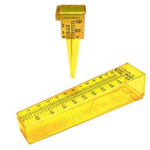

Station Number: OH-HM-24
Station Name: Cheviot 3.4 W
Report Date: 10/3/2020
Submitted: 10/03/2020 6:28 AM
Scale Bar: Mildly Dry
Description:
0.97 inches of rain here in the past week on top of very dry soil. Rainfall total at Cheviot OH 3.4W was higher than most of the area. Lawn here is green with little obvious drought stress. Rain was not enough to wet the entire soil profile. Most of the local area had less rain and some had much less rain. Much of the local area remains very dry. Dry conditions have persisted for weeks. Fall color is very early this year and appears to be peaking in localized spots, likely due to the cool weather and dry conditions. Sugar maples appeared near peak in Mt. Airy Forest this week along Shepherd Creek Road. Trees are dropping leaves. Lakes and rivers are low. Crops are brown or turning brown. Continued need to provide supplemental water to landscape trees and shrubs, particularly in areas where rainfall was not as generous in the past week.
Categories: General Awareness
Agriculture
Business & Industry
Plants & Wildlife
Society & Public Health
Water Supply & Quality

Map shows variability of 7 day rainfall in the Ohio valley.
It’s dry and getting drier. Forecast calls for more dry weather in the coming weeks. Time to water! Please delay shutting down irrigation for the year.
–

–
This report is specifically for the Arbor Doctor’s location 3.4 miles west of Cheviot, OH, in the western suburbs of Cincinnati in southwest Ohio. This location is also an official cooperative observation site for the National Weather Service listed as Cheviot 3W.
What is the Condition Monitoring Report? See these links for more information:
Explanation of scale bar>>>
–



–
Search condition monitoring reports for the entire US>>> 

A large dry area has developed from southern Illinois into southwest and west central Ohio.
Please remember to water…correctly!
Water once per week, one inch per week, under the entire branch spread, in the absence of rain, May through November. Either rainfall or your watering should equal the one inch per week. Put out a sprinkler and a straight sided soup can or rain gauge and measure one inch per week.
11-inch capacity rain gauge >>>
Taylor rain gauge >>>
Watering: How and when>>>
Watering Trees and Shrubs>>>
Soil Moisture Index:

Meteorological Versus Astronomical Seasons
Spring: March 1-May 31; Summer: June 1-August 31; Fall: September 1-November 30; Winter: December 1-February 28 (29)

You may have noticed that Arbor Doctor, meteorologists and climatologists define seasons differently from “regular” or astronomical spring, summer, fall, and winter. So, why do meteorological and astronomical seasons begin and end at different times? Climatologically, the period July 14-21, the mid-point of meteorological summer, is the hottest week of the year and the period January 14-21, the mid-point of meteorological winter, is the coldest week of the year over much of the continental US including the Ohio valley.

